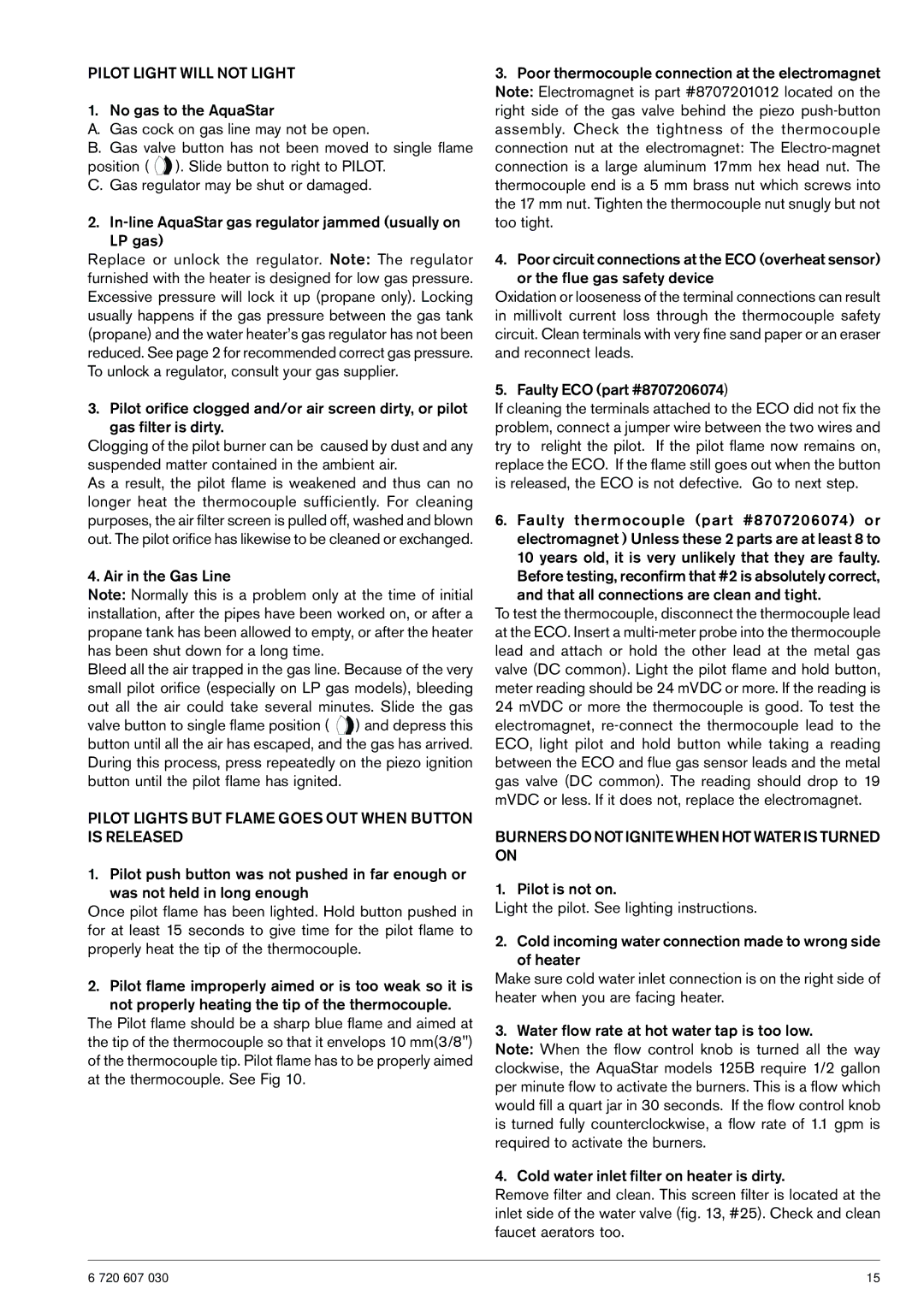PILOT LIGHT WILL NOT LIGHT
1. No gas to the AquaStar
A.Gas cock on gas line may not be open.
B.Gas valve button has not been moved to single flame position (  ). Slide button to right to PILOT.
). Slide button to right to PILOT.
C.Gas regulator may be shut or damaged.
2.In-line AquaStar gas regulator jammed (usually on LP gas)
Replace or unlock the regulator. Note: The regulator furnished with the heater is designed for low gas pressure. Excessive pressure will lock it up (propane only). Locking usually happens if the gas pressure between the gas tank (propane) and the water heater’s gas regulator has not been reduced. See page 2 for recommended correct gas pressure. To unlock a regulator, consult your gas supplier.
3.Pilot orifice clogged and/or air screen dirty, or pilot gas filter is dirty.
Clogging of the pilot burner can be caused by dust and any suspended matter contained in the ambient air.
As a result, the pilot flame is weakened and thus can no longer heat the thermocouple sufficiently. For cleaning purposes, the air filter screen is pulled off, washed and blown out. The pilot orifice has likewise to be cleaned or exchanged.
4. Air in the Gas Line
Note: Normally this is a problem only at the time of initial installation, after the pipes have been worked on, or after a propane tank has been allowed to empty, or after the heater has been shut down for a long time.
Bleed all the air trapped in the gas line. Because of the very small pilot orifice (especially on LP gas models), bleeding out all the air could take several minutes. Slide the gas valve button to single flame position (  ) and depress this button until all the air has escaped, and the gas has arrived. During this process, press repeatedly on the piezo ignition button until the pilot flame has ignited.
) and depress this button until all the air has escaped, and the gas has arrived. During this process, press repeatedly on the piezo ignition button until the pilot flame has ignited.
PILOT LIGHTS BUT FLAME GOES OUT WHEN BUTTON IS RELEASED
1. Pilot push button was not pushed in far enough or was not held in long enough
Once pilot flame has been lighted. Hold button pushed in for at least 15 seconds to give time for the pilot flame to properly heat the tip of the thermocouple.
2.Pilot flame improperly aimed or is too weak so it is not properly heating the tip of the thermocouple.
The Pilot flame should be a sharp blue flame and aimed at the tip of the thermocouple so that it envelops 10 mm(3/8") of the thermocouple tip. Pilot flame has to be properly aimed at the thermocouple. See Fig 10.
3.Poor thermocouple connection at the electromagnet Note: Electromagnet is part #8707201012 located on the right side of the gas valve behind the piezo push-button assembly. Check the tightness of the thermocouple connection nut at the electromagnet: The Electro-magnet connection is a large aluminum 17mm hex head nut. The thermocouple end is a 5 mm brass nut which screws into the 17 mm nut. Tighten the thermocouple nut snugly but not too tight.
4.Poor circuit connections at the ECO (overheat sensor) or the flue gas safety device
Oxidation or looseness of the terminal connections can result in millivolt current loss through the thermocouple safety circuit. Clean terminals with very fine sand paper or an eraser and reconnect leads.
5. Faulty ECO (part #8707206074)
If cleaning the terminals attached to the ECO did not fix the problem, connect a jumper wire between the two wires and try to relight the pilot. If the pilot flame now remains on, replace the ECO. If the flame still goes out when the button is released, the ECO is not defective. Go to next step.
6.Faulty thermocouple (part #8707206074) or electromagnet ) Unless these 2 parts are at least 8 to 10 years old, it is very unlikely that they are faulty. Before testing, reconfirm that #2 is absolutely correct, and that all connections are clean and tight.
To test the thermocouple, disconnect the thermocouple lead at the ECO. Insert a multi-meter probe into the thermocouple lead and attach or hold the other lead at the metal gas valve (DC common). Light the pilot flame and hold button, meter reading should be 24 mVDC or more. If the reading is 24 mVDC or more the thermocouple is good. To test the electromagnet, re-connect the thermocouple lead to the ECO, light pilot and hold button while taking a reading between the ECO and flue gas sensor leads and the metal gas valve (DC common). The reading should drop to 19 mVDC or less. If it does not, replace the electromagnet.
BURNERS DO NOTIGNITE WHEN HOT WATER IS TURNED ON
1. Pilot is not on.
Light the pilot. See lighting instructions.
2.Cold incoming water connection made to wrong side of heater
Make sure cold water inlet connection is on the right side of heater when you are facing heater.
3. Water flow rate at hot water tap is too low.
Note: When the flow control knob is turned all the way clockwise, the AquaStar models 125B require 1/2 gallon per minute flow to activate the burners. This is a flow which would fill a quart jar in 30 seconds. If the flow control knob is turned fully counterclockwise, a flow rate of 1.1 gpm is required to activate the burners.
4. Cold water inlet filter on heater is dirty.
Remove filter and clean. This screen filter is located at the inlet side of the water valve (fig. 13, #25). Check and clean faucet aerators too.
